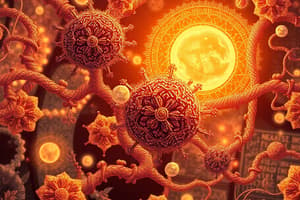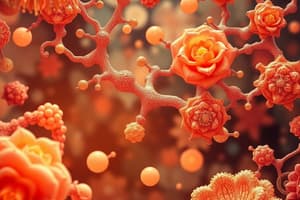Podcast
Questions and Answers
What is the significance of the active site in an enzyme?
What is the significance of the active site in an enzyme?
- It is involved in the enzyme's structural stability.
- It determines the thermal stability of the enzyme.
- It is the location where substrates bind and undergo a reaction. (correct)
- It plays no role in the enzyme's catalytic function.
Which of the following is true regarding the turnover number (kcat) of an enzyme?
Which of the following is true regarding the turnover number (kcat) of an enzyme?
- It reflects the rate at which substrate is converted to product. (correct)
- It is proportional to the enzyme concentration in a solution.
- It indicates the total time taken for a substrate to bind to an enzyme.
- It measures the amount of substrate consumed per unit time.
What is the primary characteristic that distinguishes holoenzymes from apoenzymes?
What is the primary characteristic that distinguishes holoenzymes from apoenzymes?
- Holoenzymes are inactive forms of enzymes.
- Holoenzymes are solely composed of RNA.
- Holoenzymes contain necessary cofactors or coenzymes for activity. (correct)
- Holoenzymes lack any cofactor.
How do enzyme specificity types differ?
How do enzyme specificity types differ?
What role do cofactors play in enzymatic activity?
What role do cofactors play in enzymatic activity?
Which of the following options best describes the concept of induced fit in enzyme activity?
Which of the following options best describes the concept of induced fit in enzyme activity?
What is the term for the maximum number of substrate molecules an enzyme can convert into product per unit time, often referred to as kcat?
What is the term for the maximum number of substrate molecules an enzyme can convert into product per unit time, often referred to as kcat?
Which of the following best describes the specificity of enzymes that can only facilitate reactions for a specific type of substrate?
Which of the following best describes the specificity of enzymes that can only facilitate reactions for a specific type of substrate?
What structural classification includes proteins that require additional components for activity, known as cofactors?
What structural classification includes proteins that require additional components for activity, known as cofactors?
Which type of enzyme is characterized by lacking its necessary cofactors, and thus is inactive?
Which type of enzyme is characterized by lacking its necessary cofactors, and thus is inactive?
What role do cofactors play in enzymatic activity?
What role do cofactors play in enzymatic activity?
Which of the following enzymes primarily utilize RNA to catalyze reactions, often involved in critical biological processes?
Which of the following enzymes primarily utilize RNA to catalyze reactions, often involved in critical biological processes?
What is the primary role of the active site in enzyme catalysis?
What is the primary role of the active site in enzyme catalysis?
Which of the following best describes turnover number (kcat)?
Which of the following best describes turnover number (kcat)?
What type of enzyme specificity involves the enzyme recognizing only a particular substrate among many?
What type of enzyme specificity involves the enzyme recognizing only a particular substrate among many?
What is the difference between holoenzymes and apoenzymes?
What is the difference between holoenzymes and apoenzymes?
Which of the following is a common cofactor required for enzymatic activity?
Which of the following is a common cofactor required for enzymatic activity?
Which of the following structural classes of enzymes typically facilitate oxidation-reduction reactions?
Which of the following structural classes of enzymes typically facilitate oxidation-reduction reactions?
What role do catalytic groups in the active site play during enzyme reactions?
What role do catalytic groups in the active site play during enzyme reactions?
Which aspect of the active site contributes significantly to an enzyme's catalytic efficiency?
Which aspect of the active site contributes significantly to an enzyme's catalytic efficiency?
Flashcards are hidden until you start studying
Study Notes
Enzymes Overview
- Enzymes are protein catalysts that accelerate chemical reactions without being consumed.
- Some RNA molecules (ribozymes) can also act as catalysts, primarily in phosphodiester bond cleavage and synthesis.
Active Site
- Enzymes have a unique pocket called the active site (10-20% of the protein structure).
- The active site consists of amino acid side chains essential for substrate binding and catalysis.
- Substrates bind to form an enzyme-substrate (ES) complex, leading to enzyme conformation changes (induced fit) that support catalysis.
- The ES complex transforms into an enzyme-product (EP) complex, which then dissociates into enzyme and product.
Chemistry of the Active Site
- The active site is a dynamic molecular machine, utilizing various chemical mechanisms for substrate to product conversion.
- Transition-state stabilization is key; the active site acts as a template that binds substrates, facilitating their transformation into a transition state, thereby increasing reactive intermediate concentrations and accelerating reactions.
- The active site provides specific catalytic groups that heighten the likelihood of forming the transition state.
Additional Concepts
- Catalytic Efficiency is influenced by multiple factors, including transition-state stabilization and the presence of catalytic groups within the active site.
- The process of substrate binding, transition-state stabilization, and product formation is critical for understanding enzyme functionality and reaction kinetics.
Studying That Suits You
Use AI to generate personalized quizzes and flashcards to suit your learning preferences.




